
Caterpillars are the larval stage of members of the order Lepidoptera.

A pest is any animal or plant harmful to humans or human concerns. The term is particularly used for creatures that damage crops, livestock, and forestry or cause a nuisance to people, especially in their homes. Humans have modified the environment for their own purposes and are intolerant of other creatures occupying the same space when their activities impact adversely on human objectives. Thus, an elephant is unobjectionable in its natural habitat but a pest when it tramples crops.

The cedar waxwing is a member of the family Bombycillidae or waxwing family of passerine birds. It is a medium-sized, mostly brown, gray, and yellow bird named for its wax-like wing tips. It is a native of North and Central America, breeding in open wooded areas in southern Canada and wintering in the southern half of the United States, Central America, and the far northwest of South America. Its diet includes cedar cones, fruit, and insects. The cedar waxwing is not endangered.

Eating is the ingestion of food, typically to provide a heterotrophic organism with energy and to allow for growth. Animals and other heterotrophs must eat in order to survive — carnivores eat other animals, herbivores eat plants, omnivores consume a mixture of both plant and animal matter, and detritivores eat detritus. Fungi digest organic matter outside their bodies as opposed to animals that digest their food inside their bodies. For humans, eating is an activity of daily living. Some individuals may limit their amount of nutritional intake. This may be a result of a lifestyle choice, due to hunger or famine, as part of a diet or as religious fasting.

An insectivore is a carnivorous plant or animal that eats insects. An alternative term is entomophage, which also refers to the human practice of eating insects.
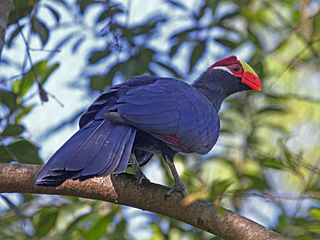
The violet turaco, also known as the violaceous plantain eater, is a large turaco, a group of African otidimorphae.

A frugivore is an animal that thrives mostly on raw fruits, succulent fruit-like vegetables, roots, shoots, nuts and seeds. Approximately 20% of mammalian herbivores eat fruit. Frugivores are highly dependent on the abundance and nutritional composition of fruits. Frugivores can benefit or hinder fruit-producing plants by either dispersing or destroying their seeds through digestion. When both the fruit-producing plant and the frugivore benefit by fruit-eating behavior the interaction is called mutualism.

A plant-based diet is a diet consisting mostly or entirely of foods derived from plants and with few or no animal-source foods. A plant-based diet is not necessarily vegetarian. The use of the phrase "plant-based" has changed over time and examples can be found of the phrase "plant-based diet" being used to refer to vegan diets, which contain no food from animal sources, and vegetarian diets, which may include dairy or eggs but no meat, as well as diets with varying amounts of animal-based foods, such as semi-vegetarian diets. The Academy of Nutrition and Dietetics states that well-planned plant-based diets support health and are appropriate throughout all life stages, including pregnancy, lactation, childhood, and adulthood, as well as for athletes.
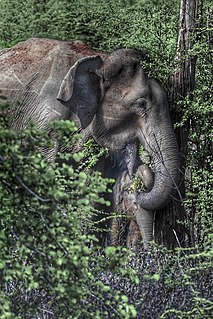
In zoology, a folivore is a herbivore that specializes in eating leaves. Mature leaves contain a high proportion of hard-to-digest cellulose, less energy than other types of foods, and often toxic compounds. For this reason, folivorous animals tend to have long digestive tracts and slow metabolisms. Many enlist the help of symbiotic bacteria to release the nutrients in their diet. Additionally, as has been observed in folivorous primates, they exhibit a strong preference for immature leaves, which tend to be easier to masticate, tend to be higher in energy and protein, and lower in fibre and poisons than more mature fibrous leaves.
Herbivores are dependent on plants for food, and have coevolved mechanisms to obtain this food despite the evolution of a diverse arsenal of plant defenses against herbivory. Herbivore adaptations to plant defense have been likened to "offensive traits" and consist of those traits that allow for increased feeding and use of a host. Plants, on the other hand, protect their resources for use in growth and reproduction, by limiting the ability of herbivores to eat them. Relationships between herbivores and their host plants often results in reciprocal evolutionary change. When a herbivore eats a plant it selects for plants that can mount a defensive response, whether the response is incorporated biochemically or physically, or induced as a counterattack. In cases where this relationship demonstrates "specificity", and "reciprocity", the species are thought to have coevolved. The escape and radiation mechanisms for coevolution, presents the idea that adaptations in herbivores and their host plants, has been the driving force behind speciation. The coevolution that occurs between plants and herbivores that ultimately results in the speciation of both can be further explained by the Red Queen hypothesis. This hypothesis states that competitive success and failure evolve back and forth through organizational learning. The act of an organism facing competition with another organism ultimately leads to an increase in the organism's performance due to selection. This increase in competitive success then forces the competing organism to increase its performance through selection as well, thus creating an "arms race" between the two species. Herbivores evolve due to plant defenses because plants must increase their competitive performance first due to herbivore competitive success.
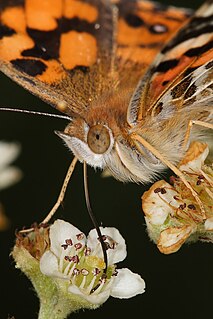
In zoology, a nectarivore is an animal which derives its energy and nutrient requirements from a diet consisting mainly or exclusively of the sugar-rich nectar produced by flowering plants.

Ross's turaco or Lady Ross's turaco is a mainly bluish-purple African bird of the turaco family, Musophagidae.

Schalow's turaco is a frugivorous bird in the family Musophagidae. This bird's common name and Latin binomial commemorate the German banker and amateur ornithologist Hermann Schalow.
Glaucous is used to describe the pale grey or bluish-green appearance of the surfaces of some plants, as well as in the names of birds, such as the glaucous gull, glaucous-winged gull, glaucous macaw, and glaucous tanager.

Fungivory or mycophagy is the process of organisms consuming fungi. Many different organisms have been recorded to gain their energy from consuming fungi, including birds, mammals, insects, plants, amoebas, gastropods, nematodes, bacteria and other fungi. Some of these, which only eat fungi, are called fungivores whereas others eat fungi as only part of their diet, being omnivores.
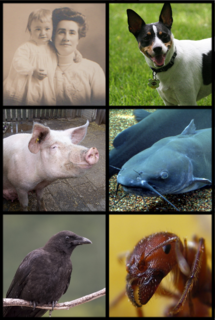
An omnivore is an animal that has the ability to eat and survive on both plant and animal matter. Obtaining energy and nutrients from plant and animal matter, omnivores digest carbohydrates, protein, fat, and fiber, and metabolize the nutrients and energy of the sources absorbed. Often, they have the ability to incorporate food sources such as algae, fungi, and bacteria into their diet.
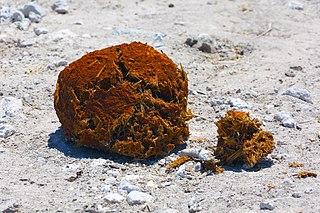
Feces is the solid or semisolid remains of food that was not digested in the small intestine, and has been broken down by bacteria in the large intestine. Feces contains a relatively small amount of metabolic waste products such as bacterially altered bilirubin, and dead epithelial cells from the lining of the gut.
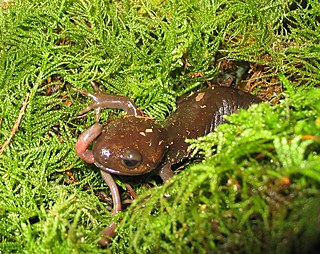
Vermivore is a zoological term for animals that eat worms. Animals with such a diet are known to be vermivorous. Some definitions are less exclusive with respect to the diet, but limit the definition to particular animals, e.g. "Feeding on worms or insect vermin. Used of a bird."
In zoology, a florivore is an animal which mainly eats products of flowers. Florivores are types of herbivores, yet within the feeding behaviour of florivory, there are a range of other more specific feeding behaviours, including, but not limited to:
















